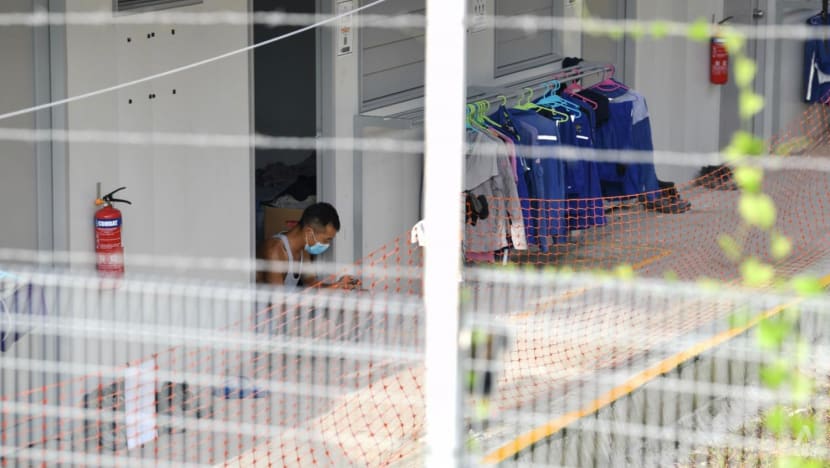Manpower Ministry monitoring Omicron situation before further easing dormitory restrictions
Ahead of International Migrants Day, Manpower Minister Tan See Leng also spoke about the efforts to improve their living and working standards.

A man uses his phone at Westlite Jalan Tukang dormitory on Oct 13, 2021. (Photo: CNA/Calvin Oh)
SINGAPORE: The Ministry of Manpower (MOM) is monitoring the Omicron variant situation “very closely” before it further relaxes COVID-19 restrictions for migrant workers living in dormitories, said Manpower Minister Tan See Leng.
Speaking to reporters ahead of International Migrants Day on Saturday (Dec 18), Dr Tan also discussed the ministry’s progress in improving living and working standards for migrant workers, as well as outlined future plans for a “more resilient migrant workforce”.
Dr Tan said that the past nine months were akin to “laying the foundation, the planning works and the structure framework”, which will provide a stable platform on which to build an improved “migrant worker ecosystem”.
“The nine months of that foundation building then allows us to then make the next lap, and this journey is just beginning,” he said in a group interview at the MOM building.
When asked if more Omicron cases might lead to restrictions being imposed again on worker dormitories, Dr Tan noted that during the Delta wave of infections in Singapore, the number of migrant workers hospitalised was “very, very low”. He added that the vaccination rate of the workers is at about 98 per cent.
“With that high level of vaccination, the preliminary data coming out of South Africa seems to be that those who are vaccinated have a very mild form of the illness,” he said.
“So we're watching it very closely. We hope that as more studies come out, and that indeed there they are actually asymptomatic, or very mild itself, we don't have to impose tight restrictions.”
Since a major outbreak of COVID-19 in the dormitories last year, migrant workers living there have been under movement restrictions, although the measures have gradually been eased in recent months.
Currently, up to 3,000 vaccinated migrant workers a day can visit any location in the community, for up to eight hours each time. Previously, it was capped at 3,000 workers a week, and the locations were limited to Little India and Geylang Serai.
Dr Tan said that while the number of requests for weekend timeslots to visit the community is “significantly higher” than for weekdays, it has been just about two weeks since the most recent easing of measures started on Dec 3. He also encouraged employers to allow their workers to stagger their days off.

3 KEY AREAS
Dr Tan said that in the next few years, MOM will focus on three key areas for the workers: Raising dormitory standards, healthcare support and enhancing their social well-being.
It will boost regulatory and enforcement levers to raise living standards in dormitories through an expanded Foreign Employee Dormitories Act.
When asked how the ministry plans to get employers on board, Dr Tan said: “A lot of the measures - we have gone through fairly extensive dialogues with different people. You will never be able to get 100 per cent of them to agree.
“But generally, we continue to get broad industries' support, and we continue to engage them … It will not be a one-step thing.”
The ministry will also upgrade existing dormitories and test new, innovative ideas for dormitory living and management.
“As far as the living standards are concerned, I think that we should be pretty soon organising a dialogue session or even a walkthrough session very early next year to share with you what some of these new standards are,” he said.
He said that his aim is to “take care of the physical and mental health of every migrant worker by providing quality, accessible and affordable healthcare”.
Last month, a new primary healthcare system was launched to ensure healthcare services for migrant workers are kept affordable. The system splits Singapore into six geographical sectors, each run by an “anchor operator”.
“Beyond public health surveillance to mitigate risks of future outbreaks, this will build stronger doctor-patient relationships and bring about better continuity of care for worker,” said Dr Tan.
The pandemic has sped up change, he added, with many more adopting telemedicine.
He said: “Now it took one pandemic like this for us to be able to literally pivot and transform telemedicine services. And it became a very useful conduit for all, in fact for many of our migrant workers to have access to medical services 24 hours a day.”
SOCIAL WELL-BEING OF WORKERS
Dr Tan said that the ministry is looking to “transform” workers’ recreation centres and will provide more details next year.
Some of the expanded range of activities at the recreation centres could include sports such as cricket and futsal games, movie screenings, performances, wellness activities including art therapy, and language and financial literacy classes.
He also said that with regular medical providers, doctors should get a better understanding of the mental state of workers who consult them, and improve the situation from a “prevention perspective”.
This is on top of a mental health support network with counselling services in the workers’ native languages, as well as support helplines.
Dr Tan made a call for partners who wish to play a more active role in caring for migrant workers, saying: “I think now the challenge in terms of moving forward is also to make sure that we are able to carry the stakeholders along with us. Because these are fairly bold and fairly strong moves moving forward.”
While the public sector will lead the way, it must make sure that the employers, dormitory operators, non-governmental organisations and others in society “move in tandem”, he said.
BOOKMARK THIS: Our comprehensive coverage of the COVID-19 pandemic and its developments
Download our app or subscribe to our Telegram channel for the latest updates on the coronavirus pandemic: https://cna.asia/telegram

















